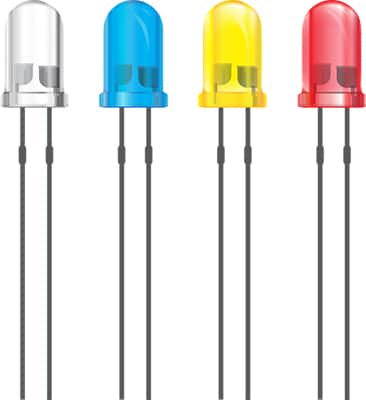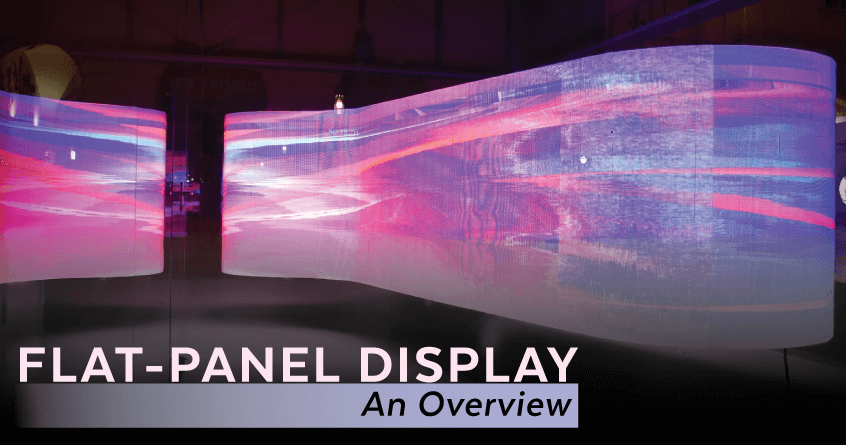When one hears the term “flat-panel display,” the first thing that may come to mind is a modern 21st-century classroom where a teacher gives lessons on an interactive flipchart to students using smart whiteboards. And this vision would not be wrong. However, this technology is being adopted into many other industries, such as:
- Automotive
- Banking
- Entertainment
- Financial services
- Healthcare
- Industrial
- Insurance
- Military and defense
- Retail
- And more
In fact, the flat-panel display market is booming. In a recent ResearchAndMarkets.com report, the global market for this technology was valued at $116.80 billion in 2018 and is projected to reach $189.60 billion by 2026.
Flat-Panel Display Defined
So, what is a flat-panel display?
The science and technology encyclopedia, HandWiki, defines flat-panel displays as follows:
Flat-panel displays are electronic viewing technologies used to enable people to see content (still images, moving images, text, or other visual material) in a range of entertainment, consumer electronics, personal computer, and mobile devices, and many types of medical, transportation and industrial equipment. They are far lighter and thinner than traditional cathode-ray tubes (CRT) television sets and video displays and are usually less than 10 centimeters (3.9 in.) thick.
 The Different Types of Flat-Panel Displays
The Different Types of Flat-Panel Displays
There are five basic types of flat-panel displays:
- LCD
- LED
- PDP
- OLED
- EL
Following is an overview of each type.
LCD (Liquid Crystal Display)
The LCD is by far the most common type of flat-panel display used today. Here’s how it works:
The LCD is comprised of millions of liquid pixels (picture elements). The picture quality is described by the number of pixels. For example, the “4K” label indicates that the display contains 3840×2160 or 4096×2160 pixels. Each pixel is made up of three subpixels: red, green, and blue (called RGB for short). When the RGBs in a pixel change color combinations, a different color is produced (e.g., red and green produce yellow). With all the pixels working together, the display can make millions of different colors. And finally, a picture is created when the pixels are rapidly turned off and on.
LED Displays (Light-Emitting Diode)
LED displays are the second most common display technology. In essence, the LED display is an LCD as it uses the same liquid diode technology but uses light-emitting diodes to backlight instead of cold cathode fluorescent (CCFL) backlighting.
LEDs are more expensive than LCDs but have several advantages. Compared to LCDs, LEDs:

- Use less electricity
- Are thinner
- Have higher contrast
- Produce more vivid colors
- Are more durable
- Have a flicker-free image
- Have less environmental impact
OLED Displays (Organic Light-Emitting Diode)
The “O” in OLED stands for “organic,” as these flat-panel displays are made of organic materials (like carbon, plastic, wood, and polymers) that are used to convert electrical current into light. With OLED technology, each pixel is capable of producing its own illumination. Whereas both LCD and LED technology uses a backlighting system.
OLEDs are noted for the following features:
- Exceptional picture quality
- Fast response
- No ghosting
- Wide viewing angles
The drawbacks of OLEDs are that they are quite pricey, extra sensitive to water, and have a much shorter life expectancy than LCDs and LEDs.
PDP (Plasma Display Panel)
PDPs contain an electrically charged gas (plasma) that is housed between two panels of glass. PDPs are known for their vivid colors and have a wider viewing angle. However, one disadvantage with this technology is that it tends to “burn” permanent images onto the viewing area. In addition, when compared to an LCD, the PDP tends to be heavier and thicker because of the two glass panels, and it typically uses more electricity.
EL Displays (Electroluminescent)
EL Technology places electroluminescent material (such as gallium arsenide or GaAs) between two conductive layers. When an electric current is introduced to the layers, the electroluminescent material lights up, thus creating a pixel. EL displays are most typically used for instrumentation for rugged military, transportation, and industrial applications.
How Industries Are Implementing Flat-Panel Displays
In today’s world, interactivity is king. Devices like mobile phones and tablets are everywhere, and people are looking for similar experiences in their workplace and as they go about their daily lives. As a result, multi-video walls, kiosks, and interactive flat-panel displays are cropping up in almost any place you can think of.
Automotive
Automobile dealerships are installing interactive flat-panel displays that allow shoppers to view their line-up of cars. These panels have touchscreen features that enable customers to view a vehicle from all angles and even zoom in on different parts. With this technology, buyers can order a fully customized car by choosing the upholstery, trim, accessories, and even some of the engine features of their new car.
Healthcare
Doctors have many non-invasive diagnostic tools in their toolkits—things like x-rays, MRIs, CT scans, ultrasound, PET, etc. These days, new techniques have been developed that combine multiple scans into 3D renderings. These images require high-quality (medical-grade) flat-panel displays that provide the highest resolution possible. And because these displays are in constant use, they must be durable and long-lived. LCDs with edge-lit LED backlights are currently the industry standard with about 93 percent penetration.
Military
One of the best weapons in peace and war is information. The Pentagon is placing flat-panel displays on almost every surface they can think of—war rooms, control rooms, ships, planes, trucks, and even helmets, rifle sights, and radios. The displays used by the military must be:
- Ultra-durable
- Low cost
- Sunlight readable
- Lightweight
- Power-efficient
- High resolution
Retail
Brick and mortar retail stores’ biggest competition is e-commerce sites. Interactive flat-panel displays combine in-store and online selling with the use of self-service kiosks. Salespeople are using these kiosks to personalize customer service and enhance their product availability beyond what they stock in the store. This technology can also help retailers customize their products for their customers and are particularly helpful to boutiques and luxury retailers.
To Finish Up
As we have demonstrated, there are many uses for flat-panel displays in a multitude of sectors. Flat-panel displays produce high-quality images, are stylish, consume less power, and give a maximum image in a minimum space. Best of all, they disperse information and help make our lives easier and safer.
Versa Technology’s objective is to keep our customers fully informed about a broad array of communication and networking technologies. We sincerely hope you found this article informative. Versa has over 25 years of experience in networking solutions. To learn more about our products and services, please visit our homepage.

